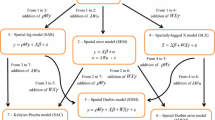Abstract.
This paper develops statistical methods for analyzing the distribution of spatial objects—points, convex polygons, and line segments—in relation to a surface. We propose statistics for measuring the relationship between the distribution of these objects and a surface and derive their expectations and variances under the null hypothesis that the objects are independently and randomly distributed. The statistics are approximately distributed according to the normal distribution under the null hypothesis, which enables us to test the significance of the spatial relationships statistically. Using the proposed methods, we empirically analyze the distribution of convenience stores in relation to the distribution of population in a suburb of Osaka, Japan. Some empirical findings are shown.
Similar content being viewed by others
Author information
Authors and Affiliations
Rights and permissions
About this article
Cite this article
Sadahiro, Y. Statistical methods for analyzing the distribution of spatial objects in relation to a surface. J Geograph Syst 1, 107–136 (1999). https://doi.org/10.1007/s101090050008
Issue Date:
DOI: https://doi.org/10.1007/s101090050008




